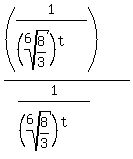|
Question 347820: 1) The population P of deers at t years is given by P= (2000a^t)/(4+a^t)
where a is constant.Given that there are 800 deers in the park after 6 years,
a) Find the value of a to 4 dp (i got 1.1776..is that right?)
b)Use the model to predict the number of years needed for the population of deer to increase from 800 to 1800
c)With reference to this model explain why the population of deer cannot exceed 2000
2)Find the roots A and B where A
Thanks
Answer by jsmallt9(3758)   (Show Source): (Show Source):
You can put this solution on YOUR website! a) "a" =  which is approximately 1.1776... which is approximately 1.1776...
This makes your equation: 
b) First we find the years it takes the population to reach 1800:

Multiply both sides by  : :

Subtract  from each side: from each side:

Divide both sides by 200:

Find the logarithm of each side, using a base that your calculator "knows":

Use the property of logarithms,  , to move the exponent/variable out in front: , to move the exponent/variable out in front:

Divide both sides by  : :

Use your calculator for a decimal approximation:

This is how long it takes for the population to reach 1800. For the time it takes for the population to increase from 800 to 1800, just subtract the 6 years it took to reach 800: 151.9213625253483390.
c) To answer this part, take the equation:

and multiply the numerator and denominator on the right by:  . (You'll see why when we're done.) . (You'll see why when we're done.)

Multiplying the numerators and using the Distributive Property on the denominators we get:

With the equation in this form and with some knowledge about how exponents and fractions work we can figure out why the deer population will never exceed 2000:- Since t is time it can never be negative. The lowest value it can be is zero. When t = 0,
 . Since any nonzero number to the zero power is 1 we get: . Since any nonzero number to the zero power is 1 we get:  . So the population at t = 0 (IOW the initial population) is 400. . So the population at t = 0 (IOW the initial population) is 400. - As t increases,
 increases increases - As
 increases, increases,  decreases (because as the denominator increases the value of the entire fraction decreases) decreases (because as the denominator increases the value of the entire fraction decreases) - As
 decreases, decreases,  decreases decreases - As
 decreases, decreases,  increases (because as a denominator decreases, the value of the entire fraction increases). increases (because as a denominator decreases, the value of the entire fraction increases). - So the highest population will come with the highest value of t.
- For very large values of t, the denominator of
 will become an extremely large positive number. And a fraction with a positive numerator and an extremely large positive denominator will be a positive fraction which is very, very close to zero. will become an extremely large positive number. And a fraction with a positive numerator and an extremely large positive denominator will be a positive fraction which is very, very close to zero. - If
 is a positive number very close to zero then is a positive number very close to zero then  will be a number just a tiny bit above 1. will be a number just a tiny bit above 1. - And if
 is a number just barely above 1, then is a number just barely above 1, then  is a number just barely below 2000. is a number just barely below 2000.
This is why the population will never exceed 2000. (In fact, since  can never actually be zero, can never actually be zero,  can never actually be 1 and the population can never actually be 2000.) can never actually be 1 and the population can never actually be 2000.)
|
|
|
| |